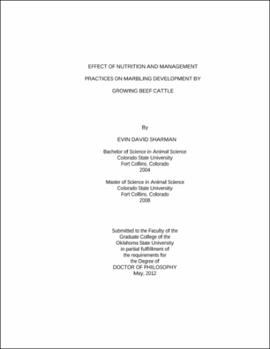| dc.description.abstract | Three experiments were conducted to determine the effects of energy supplementation, rate of gain, and type of fermentation from different grazing programs on subsequent finishing performance, carcass characteristics, body composition, and visceral organ mass in growing beef cattle. The first experiment examined the effects of starch- vs. fiber based energy supplements in steers grazing dormant native range (DNR). Energy supplementation increased grazing ADG compared with the control steers, and the starch supplemented steers had greater ADG compared with the two fiber-based supplemented treatments. At intermediate harvest, energy supplementation increased mesenteric fat deposition compared with the control steers, but there were no differences in 12th-rib fat or marbling score. At the end of finishing, there were no differences in final carcass quality suggesting that total energy intake was too low in this production system to influence marbling deposition. The second and third experiment examined the effects of forage energy intake and type of fermentation on fat deposition in stocker cattle grazing DNR or winter wheat pasture (WP). The control and starch-based energy supplement were the same as in the first experiment, but 2 different stocking rates were used on WP to produce differing rates of gain. The experiments were designed to determine differences in fat deposition at a similar age and similar HCW prior to finishing and the subsequent effects on finishing performance and final carcass quality. Grazing ADG was 0.19, 0.52, 0.68, and 1.37 kg/d in the second experiment and 0.49, 0.63, 0.84, and 1.41 kg/d in the third experiment for the control, starch-supplemented, and low and high rate of gain wheat pasture steers, respectively. At intermediate harvest, the WP treatments had greater 12th-rib fat, marbling score, and carcass body fat compared with the DNR treatments. At the end of finishing, there were no differences in final carcass quality or carcass body fat among the treatments for either experiment. These results show that stocker cattle grazing programs that result in higher rates of gain and (or) higher ruminal propionate concentrations increase intramuscular fat and 12th-rib fat at the end of grazing. Intramuscular fat increased linearly with rate of gain and energy intake during the stocker phase, whereas 12th-rib fat increased quadratically. However, final marbling score was not influenced by the different grazing programs when steers were fed to a similar 12th-rib fat endpoint. | |
